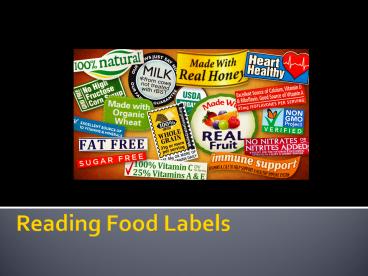Reading Food Labels PowerPoint PPT Presentation
Title: Reading Food Labels
1
Reading Food Labels
2
What is Nutrition Labeling
- Information found on the labels of prepackaged
foods - In Canada each prepackages food item must
include - Nutritional facts table
- Ingredients List
- Optional nutrition claims
- You can use all this information to make
healthier food choices and achieve overall good
health
3
Did you know that Nutritional labeling became
mandatory for all prepackaged foods on Dec. 12,
2007!
4
Nutritional Facts Table
- Look at the labels on your desk. Make a list of
the information included on it!
5
The Nutritional Facts Table
- Gives you information about
- Calories
- 13 core nutrients
- daily value (DV) of nutrients
- Based on the AMOUNT OF FOOD
- http//www.eatrightontario.ca/en/Videos/Nutrition-
Labelling/Episode-1-of-5--Introduction-to-Nutritio
n-Labellin
6
Core Nutrients
- Fat
- saturated and trans
- Cholesterol
- Sodium
- Carbohydrates
- Fibre
- Sugars
- Proteins
- Vitamin A
- Vitamin C
- Calcium
- Iron
7
(No Transcript)
8
What percentage of your calories
- You should intakes 10-35 of your calories in
the form of Proteins - On a 1 800 calorie diet that is 50-145 g/ day
- You should intakes 45-65 of your calories in
the form of CARBS - On a 1 800 calorie diet that is 210-290 g/ day
- You should intakes 20-35 of your calories in
the form of fat - On a 1 800 calorie diet that is 40-65 g/ day
9
Good Fat vs. Bad Fat
- Good Fat from oils, nuts, seeds and fatty fish
- Omega-3 fat in milk, cheese, eggs, fatty ish
- Omega-6 fat in most oils
- Good fat helps to lower cholesterol
- Bad Fat increase cholesterol levels and heart
disease - Saturated should only be 10 of calorie intake
- trans fat should be as close to zero as possible
10
Why use the Nutrition Facts Table?
- You can use the Nutrition Facts table to
- Choose products more easily.
- Compare two products to make better food choices
for you and your family. - Learn about the nutrition information of the
foods you eat. - Better manage special diets.
- Increase or decrease your intake of any nutrient.
11
Did you know?
- Using the Nutrition Facts table is worth it!
- Making healthy food choices can help reduce your
risk of nutrition-related chronic diseases such
as cancer, diabetes, heart disease and stroke.
12
Where do you find the Nutrition Facts Table?
- Almost all pre-packaged foods have a Nutrition
Facts table. It looks the same on most foods.
This makes it easy to find and easy to read. - Not all foods need to have a Nutrition Facts
table. These foods are not required to have a
Nutrition Facts table - Fresh vegetables and fruits
- Raw meat and poultry (except when it is ground)
- Raw fish and seafood
- Foods prepared or processed at the store (bakery
items, salads, etc) - Foods that contain very few nutrients such as
coffee, tea, herbs and spices - Alcoholic beverages
13
Next class
- We will look at daily value
- You will also be completing a food label handout!

